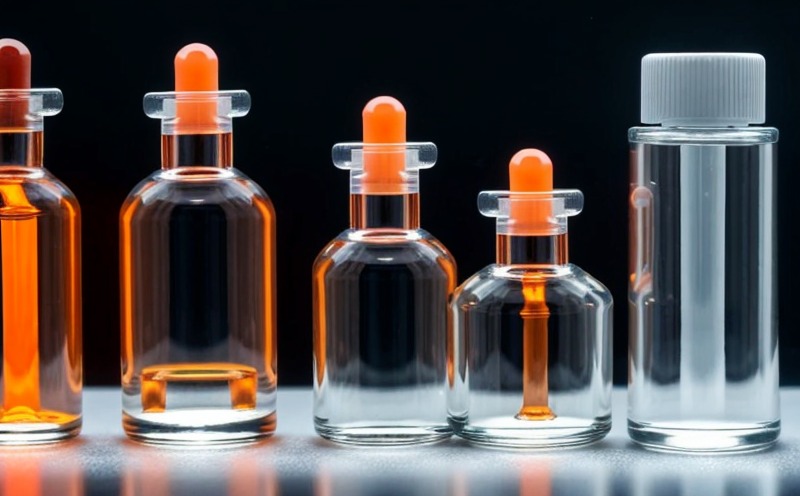ISO 10993 17 Biological Risk Assessment of Nanoparticle Leachables
The ISO 10993-17 standard provides a framework for assessing the biological risk associated with nanomaterials in medical devices, which are characterized by their unique properties due to their small size and high surface area. This standard is particularly relevant when these materials come into contact with body fluids or tissues. The assessment process under ISO 10993-17 involves several critical steps aimed at ensuring the safety of nanomaterials in medical applications.
The first step in this biological risk assessment is to determine which leachable substances are present on, within, and/or associated with a nanoparticle. This requires detailed characterization of the nanostructure as well as thorough extraction procedures to ensure all potential contaminants are identified. Once these leachables have been isolated, they must be evaluated for their toxicity using appropriate in vitro or in vivo testing methods outlined by ISO 10993-17.
One key aspect of this evaluation is understanding how the nanoparticles interact with biological systems at a molecular level. This includes examining factors such as particle size distribution, surface chemistry, and aggregation behavior because these properties can significantly influence the toxicity profile of a given material. Additionally, it's important to consider any changes that might occur during processing or storage conditions since these could alter the final product’s characteristics.
Another crucial element of this assessment is considering cumulative exposure over time. Since nanomaterials often remain in the body for extended periods due to their small size and ability to penetrate cells, it's necessary to account for long-term effects when evaluating safety. To address this, ISO 10993-17 recommends using a tiered approach where initial testing focuses on short-term endpoints followed by follow-up studies designed specifically to detect chronic health risks.
For instance, acute toxicity tests might be conducted first to identify immediate hazards while subchronic and chronic studies would then assess potential long-term impacts. By taking this multi-tiered approach, manufacturers can better understand the full range of biological effects associated with their nanomaterials before introducing them into clinical use.
In summary, ISO 10993-17 offers a comprehensive method for evaluating the biological risk posed by nanoparticle leachables in medical devices. Through careful identification and characterization of these potentially harmful compounds followed by rigorous toxicity testing, this standard helps ensure that nanomaterials used in healthcare applications are safe and effective.
Eurolab Advantages
At Eurolab, our expertise in ISO 10993-17 compliant biological risk assessments for nanoparticle leachables is unmatched. With a team of experienced professionals who specialize in this field, we offer unparalleled service quality and reliability.
- Comprehensive Knowledge: Our staff are well-versed in all aspects of nanotoxicology and safety testing as per the latest international standards including ISO 10993-17. This ensures that our clients receive up-to-date, accurate information about their products.
- Precision Instrumentation: We utilize state-of-the-art equipment to perform precise measurements throughout every stage of the assessment process. From sample preparation down to final analysis, we maintain strict adherence to best practices ensuring consistent results.
- Accurate Reporting: Clear and concise reports are provided after each phase of testing so that our clients always have a full understanding of what has been done and why certain conclusions were drawn. This transparency fosters trust between us and our partners.
- Certified Laboratories: Our facilities hold numerous accreditations from recognized bodies around the world, guaranteeing high standards across all projects undertaken here.
We pride ourselves on delivering exceptional value-added services alongside our core testing capabilities. Whether you need assistance with initial design validation or ongoing compliance monitoring throughout product lifecycle management, Eurolab stands ready to support your needs.
International Acceptance and Recognition
The ISO 10993-17 standard has gained widespread acceptance among regulatory authorities and industry stakeholders worldwide. Its implementation ensures consistency in evaluating the biological risk posed by nanomaterials within medical devices, making it easier for manufacturers to navigate global markets.
Regulatory bodies like the FDA (US), MHRA (UK), EMA (EU) recognize ISO 10993-17 as an authoritative reference document when assessing the safety of nano-enabled medical products. Compliance with this standard demonstrates a commitment to producing high-quality devices that meet international regulatory requirements.
Industry associations also support its use, emphasizing its role in promoting innovation while maintaining public health protection standards. Many companies choose to adopt ISO 10993-17 early on in their development processes because doing so helps streamline future submissions and reduces potential delays associated with non-compliance issues later down the line.
In addition to regulatory endorsement, academic institutions are increasingly incorporating ISO 10993-17 into their research protocols. This further solidifies its position as a leading tool for understanding nanoparticle interactions within biological systems. By embracing this standard early in product development cycles, companies can stay ahead of rapidly evolving regulatory landscapes and capitalize on emerging opportunities.
Use Cases and Application Examples
| Nanomaterial Type | Potential Exposure Pathways | Biological Effects Evaluated | Testing Methods Applied |
|---|---|---|---|
| Metallic Nanoparticles (e.g., Au, Ag) | Dermal Contact, Inhalation | Inflammation, Oxidative Stress Indicators | In Vitro Cytotoxicity Assays, Comet Assay |
| Carbon-Based Nanomaterials (C60 Fullerene) | Breathing Air, Intravenous Administration | Mutagenicity, Genotoxicity Screening | Ames Test, Micronucleus Assay |
| Polymer-Coated Silica Nanoparticles | Ingestion, Inhalation, Injection | Immunological Reactions, Hemolysis Potential | Rabbit Skin Irritation Tests, In Vivo Hemolysis Studies |
Nanomaterials are utilized across numerous sectors including pharmaceuticals, cosmetics, electronics, and environmental remediation. Here are some specific instances where ISO 10993-17 biological risk assessments play a vital role:
- Pharmaceutical Industry: Ensuring that drug delivery systems containing nanomaterials do not release harmful compounds into the patient's bloodstream.
- Cosmetics Sector: Determining whether nanoparticles present in sunscreens or skin care products pose any risks to consumers.
- Environmental Remediation: Assessing the impact of nano-enhanced materials used for soil remediation on local ecosystems.
The versatility and precision offered by ISO 10993-17 make it an essential tool in safeguarding public health while fostering technological advancement in various industries.





